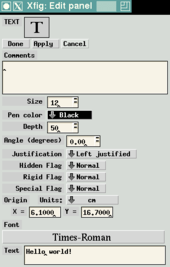Xfig
| Xfig
|
|
|---|---|
 Xfig with example drawings. |
|
| Basic data
|
|
| Publishing year | 1985 |
| Current version | 3.2.7a (May 2018) |
| operating system | Linux , Mac OS X , Microsoft Windows , FreeBSD , Solaris |
| programming language | C and Xlib |
| category | Vector graphics program |
| License | Free / Libre open source software , MIT license |
| German speaking | No |
| http://mcj.sourceforge.net/frm_main_menus.html | |
Xfig is a vector - drawing program , which on most Unix -compatible operating systems under the X Window System running with open source code similar to terms of the BSD license is freely available.
The first version is from 1985 by Supoj Sutanthavibul. Overall, it is based on ideas and suggestions from Donald E. Fussell (Professor at the University of Texas at Austin ).
With Xfig, drawings can be made that consist of objects such as circles, rectangles, lines, polygons, splines, text, etc. Furthermore, images in formats such as PNG , GIF , JPEG , EPSF ( PostScript ) etc. can be imported. These objects can be created, deleted, moved or changed. Various attributes such as colors or line styles are available. There are 35 fonts to choose from for pasted text.
Xfig saves the graphics in its own, text-based Fig format , but can export them to various other formats such as (encapsulated) PostScript, PDF , GIF, JPEG, HP-GL and others with the help of the associated Transfig program .
Dialogs are used in a somewhat unusual way: on the one hand, each text field has a permanent cursor in the form of a circumflex, and on the other hand, the writing focus is automatically placed on a text field without clicking as soon as the mouse pointer is over it.
A special feature of Xfig is that drawings can be labeled with LaTeX . The output can thus be in two files: a graphic part in PostScript or PDF and a textual part with LaTeX commands. These possibilities are achieved by integrating Transfig .
Use Xfig files on other operating systems
The JFig program , which is based on the platform-independent programming language Java , can also process files in .fig format. This means that .fig files can be used on all platforms on which Java is available. Windows users can also make Xfig executable with the Cygwin library or edit .fig files with the WinFIG program . In contrast to the Xfig available for Unix, both JFig and WinFig are not available for free, but only against license fees. AmiFIG is available as open source for AmigaOS , AROS and MorphOS .
Web links
- official website ( Memento of April 2, 2016 in the Internet Archive )
- Homepage of JFig ( Memento from September 11, 2014 in the Internet Archive ) (Download discontinued June 14, 2010)
- User guide ( Memento of March 4, 2016 in the Internet Archive ) (English)
- Install Xfig on Windows ( Memento from May 22, 2001 in the Internet Archive )
- WinFIG, a Xfig-compatible drawing program for Windows (Demo, no import support, August 8, 2011)

